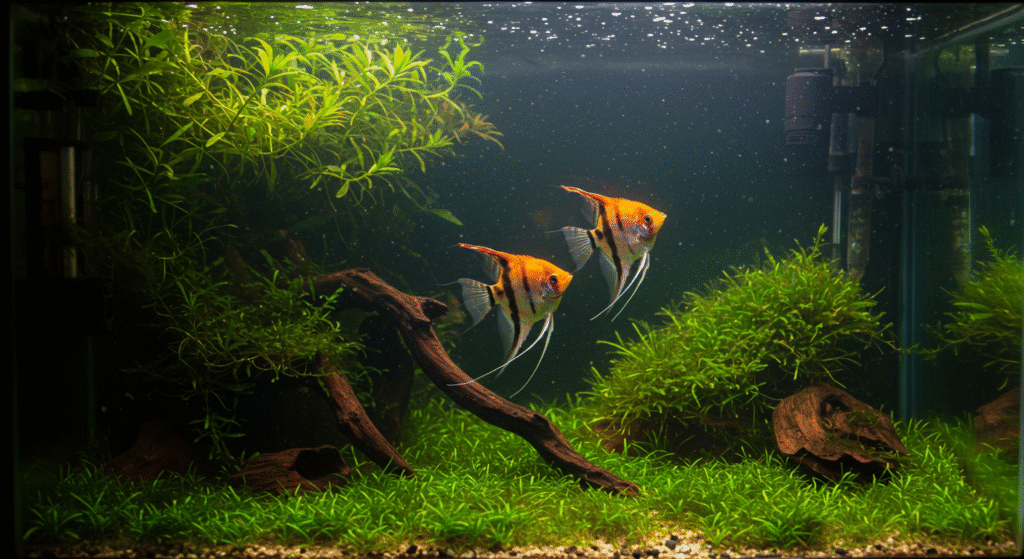When we think of angelfish, their graceful swimming and vibrant patterns come to mind.
They’re a favorite among aquarium enthusiasts, but not every tank size is ideal for these beauties.
If you’re considering housing angelfish in a 10-gallon tank, you might want to pause and rethink.
Let’s explore why tank size matters and the most suitable setup for these stunning fish.
What Makes Angelfish Special?
Angelfish are one of the most popular freshwater species, thanks to their unique triangular shape and flowing fins.
Originating from the Amazon River, they’re hardy but have specific needs.
Understanding their natural habitat and behaviors is key to providing a healthy environment.
- Typical Size: Adult angelfish can grow up to 6 inches long and 8 inches tall.
- Social Nature: They’re semi-aggressive and territorial, especially in small spaces.
- Lifespan: With proper care, they can live up to 10 years.
Why Tank Size Matters for Angelfish
Choosing the right tank size isn’t just about aesthetics; it directly impacts your fish’s health and happiness. Here’s why:
- Swimming Space: Angelfish are active swimmers and require vertical and horizontal space.
- Water Stability: Smaller tanks are harder to maintain in terms of water quality and temperature.
- Stress Levels: Cramped spaces can lead to aggression, stress, and health issues.
Can You Keep Angelfish in a 10-Gallon Tank?
The short answer is no. A 10-gallon tank is far too small for even one angelfish. Here’s why:
- Size Mismatch: Adult angelfish need more room to move comfortably.
- Poor Water Quality: Small tanks have less water volume, making it challenging to dilute waste effectively.
- Behavioral Issues: Confined spaces increase aggression among angelfish, especially when paired with other fish.
Ideal Tank Size for Angelfish
For one angelfish, a minimum of 20 gallons is recommended.
If you’re planning to keep a pair, aim for at least 30 gallons.
For a community tank with other species, go for 50 gallons or more.
Factors to Consider:
- Tank height should accommodate their tall bodies.
- Provide plenty of hiding spots and open swimming areas.
- Ensure proper filtration to maintain water quality.
The Challenges of Keeping Angelfish in Small Tanks

Let’s break down the problems you’ll encounter with a 10-gallon tank:
1. Limited Space for Growth
Angelfish don’t just stay small. As they grow, they’ll feel cramped, which can stunt their growth and cause deformities.
2. Water Quality Concerns
Small tanks accumulate waste quickly, leading to spikes in ammonia and nitrites. This can be fatal to angelfish, who are sensitive to poor water conditions.
3. Increased Aggression
Angelfish are territorial. A small tank amplifies their aggression, leading to fights and stress among tank mates.
Best Fish for a 10-Gallon Tank
If you’re set on using a 10-gallon tank, consider smaller species that thrive in limited space. Here are some great options:
- Betta Fish: Stunning and low-maintenance.
- Neon Tetras: Perfect for schooling fish lovers.
- Shrimp: A great addition for cleaning up algae.
- Guppies: Colorful and easy to care for.
Setting Up the Perfect Tank for Angelfish
Want to ensure your angelfish are thriving? Follow these tips:
1. Choose the Right Tank Size
As we mentioned, start with at least 20 gallons. More space means happier fish.
2. Mimic Their Natural Habitat
- Use soft, slightly acidic water.
- Add plants and driftwood for hiding spots.
- Ensure proper lighting to replicate their natural environment.
3. Prioritize Filtration and Aeration
Angelfish produce waste, so a high-quality filter is non-negotiable. Aerators can help maintain oxygen levels.
Common Mistakes to Avoid
- Overcrowding: Too many fish in one tank spells disaster.
- Inadequate Filtration: A poor filter leads to dirty water and sick fish.
- Ignoring Tank Mates: Choose compatible species to avoid aggression.
FAQs
1. Can angelfish survive in a 10-gallon tank temporarily?
While they might survive for a short time, it’s not ideal. Stress and poor water quality can quickly lead to health issues.
2. How many angelfish can I keep in a 20-gallon tank?
One angelfish is ideal for a 20-gallon tank. If you want a pair, upgrade to at least 30 gallons.
3. What are the best tank mates for angelfish?
Go for peaceful species like Corydoras catfish or larger tetras. Avoid fin-nippers like barbs.
4. How often should I clean the tank for angelfish?
Perform weekly water changes (20-25%) and clean the substrate to maintain water quality.
5. What happens if I overcrowd my tank?
Overcrowding leads to stress, aggression, and poor water quality, which can be fatal for angelfish.
Conclusion
A 10-gallon tank might seem like an affordable and space-saving choice, but it’s far from ideal for angelfish.
These majestic fish need room to swim, grow, and thrive.
By choosing a larger tank and providing the right environment, you’ll ensure your angelfish live long, happy lives.


1 thought on “Angelfish Tank Size: Can They Live in 10 Gallons?”